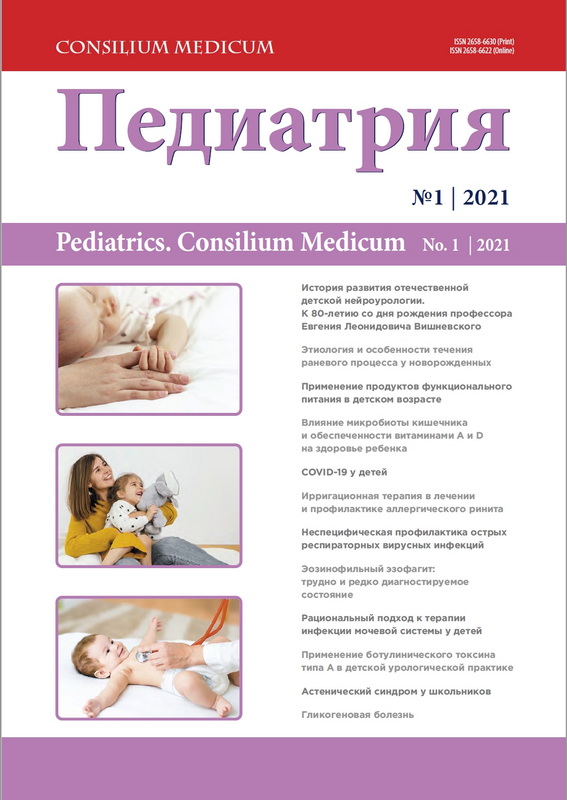Botulinum toxin type A in pediatric urological practice: current state of the problem and future perspectives
- 作者: Romashin M.A.1,2, Guseva N.B.1,2, Mlynchik E.V.1,2, Ignatyev R.O.1,2
-
隶属关系:
- Pirogov Russian National Research Medical University
- Speransky Children’s City Clinical Hospital №9
- 期: 编号 1 (2021)
- 页面: 72-75
- 栏目: Articles
- URL: https://pediatria.orscience.ru/2658-6630/article/view/71111
- DOI: https://doi.org/10.26442/26586630.2021.1.200699
- ID: 71111
如何引用文章
全文:
详细
Botulinum toxin was used in medicine in the middle of the 20th century. Studies in various fields around the world have proven its high safety profile and are successfully used in clinics in different countries. In pediatric urology, botulinum toxin is used for chemodenervation of the bladder detrusor and urethral sphincter. The main contingent for the use of botulinum toxin type A (BTTA) is children with myelodysplasia (that is, with organic lesions of the spinal cord and, as a result, impaired innervation of the pelvic organs), the manifestations of which are urgency urinary incontinence, which represents a significant deterioration in the quality of life and difficulties in socialization and normal life of children. In addition, gallbladder-dependent ureterohydronephrosis is often found in these patients, as a result of hyperactivity and hypertonicity of the detrusor, increased intravesical pressure and the presence of residual urine. In both of the above cases, chemodenervation of the detrusor using botulinum toxin shows excellent results, and therefore this method is gaining popularity all over the world. Nevertheless, in pediatric practice, the indications for the introduction of BTTA are not clearly formulated, and there are currently few studies and, accordingly, the results of its use. The aim of this work is to review the accumulated data on the use of BTTA and their interpretation.
全文:
作者简介
Maksim Romashin
Pirogov Russian National Research Medical University; Speransky Children’s City Clinical Hospital №9
编辑信件的主要联系方式.
Email: romashinmaxim17@yandex.ru
ORCID iD: 0000-0003-3480-9812
Research Assistant
俄罗斯联邦, Moscow; MoscowNatalia Guseva
Pirogov Russian National Research Medical University; Speransky Children’s City Clinical Hospital №9
Email: gusevan-b@yandex.ru
ORCID iD: 0000-0002-1583-1769
D. Sci. (Med.)
俄罗斯联邦, Moscow; MoscowElena Mlynchik
Pirogov Russian National Research Medical University; Speransky Children’s City Clinical Hospital №9
Email: mlynchik@yandex.ru
ORCID iD: 0000-0003-2606-1218
Cand. Sci. (Med.)
俄罗斯联邦, Moscow; MoscowRoman Ignatyev
Pirogov Russian National Research Medical University; Speransky Children’s City Clinical Hospital №9
Email: romarion74@mail.ru
ORCID iD: 0000-0002-6393-1326
D. Sci. (Med.)
俄罗斯联邦, Moscow; Moscow参考
- Jabbari B. History of botulinum toxin treatment in movement disorders. Tremor Other Hyperkinet Mov (NY) 2016; 6: 394. doi: 10.7916/D81836S1
- Monheit GD, Pickett A. AbobotulinumtoxinA: A 25-year history. Aesthet Surg J 2017; 37 (Suppl. 1): 4–11. doi: 10.1093/asj/sjw284
- Peck MW, Smith TJ, Anniballi F, et al. Historical perspectives and guidelines for botulinum neurotoxin subtype nomenclature. Toxins (Basel) 2017; 9 (1): 38. doi: 10.3390/toxins9010038
- Pirazzini M, Rossetto O, Eleopra R, Montecucco C. Botulinum neurotoxins: biology, pharmacology, and toxicology. Pharmacol Rev 2017; 69 (2): 200–35. doi: 10.1124/pr.116.012658
- Лазишвили М.Н. Эфферентные методы лечения нейрогенной дисфункции мочевыводящих путей у детей с синдромом миелодисплазии. Дис. … канд. мед. наук. М., 2014 [Lazishvili MN. Efferentnye metody lecheniia neirogennoi disfunktsii mochevyvodiashchikh putei u detei s sindromom mielodisplazii. Dis. ... kand. med. nauk. Moscow, 2014 (in Russian)].
- Гусева Н.Б., Игнатьев Р.О. Миелодисплазия у детей (организация и оказание специализированной медицинской помощи): руководство для врачей. Под ред. Розинова В.М. М.: Предание, 2017 [Guseva NB, Ignatiev RO. Myelodysplasia in children (organization and provision of specialized medical care): a guide for doctors. Ed. Rozinov VM. Moscow: Tradition, 2017 (in Russian)].
- Данилов В.В., Данилов В.В. Нейроурология: в 3 т. Владивосток: Клуб Директоров, 2019. Т. 1 [Danilov VV, Danilov VV. Neurourology: in 3 volumes. Vladivostok: Directors Club, 2019. Vol. 1 (in Russian)].
- Lee YK, Kuo HC. Therapeutic effects of botulinum toxin A, via urethral sphincter injection on voiding dysfunction due to different bladder and urethral sphincter dysfunctions. Toxins (Basel) 2019; 11 (9): 487. doi: 10.3390/toxins11090487
- Multani I, Manji J, Hastings-Ison T, et al. Botulinum toxin in the management of children with cerebral palsy. Paediatr Drugs 2019; 21 (4): 261–81. doi: 10.1007/s40272-019-00344-8
- Sager C, Burek C, Durán V, et al. Pharmacotherapy in pediatric neurogenic bladder intravesical botulinum toxin type A. ISRN Urol 2012; 2012: 763159. doi: 10.5402/2012/763159
- Sakalis VI, Oliver R, Guy PJ, Davies MC. Macroplastique and botox are superior to macroplastique alone in the management of neurogenic vesicoureteric reflux in spinal cord injury population with presumed healthy bladders. J Spinal Cord Med 2019; 42 (4): 478–84. doi: 10.1080/10790268.2018.1433266
- Tyagi P, Kashyap M, Yoshimura N, et al. Past, present and future of chemodenervation with botulinum toxin in the treatment of overactive bladder. J Urol 2017; 197 (4): 982–90. doi: 10.1016/j.juro.2016.11.092
- Wu SJ, Xu YQ, Gao ZY, et al. Clinical outcomes of botulinum toxin A management for neurogenic detrusor overactivity: meta-analysis. Ren Fail 2019; 41 (1): 937–45. doi: 10.1080/0886022X.2019.1655448
- Kuo YC, Kuo HC. Adverse events of intravesical onabotulinumtoxinA injection between patients with overactive bladder and interstitial cystitis-different mechanisms of action of botox on bladder dysfunction? Toxins (Basel) 2016; 8 (3): 75. doi: 10.3390/toxins8030075
- Kaviani A, Khavari R. Disease-specific outcomes of botulinum toxin injections for neurogenic detrusor overactivity. Urol Clin North Am 2017; 44 (3): 463–74. doi: 10.1016/j.ucl.2017.04.012
- Chuang YC, Kaufmann JH, Chancellor DD, et al. Bladder instillation of liposome encapsulated onabotulinumtoxina improves overactive bladder symptoms: a prospective, multicenter, double-blind, randomized trial. J Urol 2014; 192 (6): 1743–9. doi: 10.1016/j.juro.2014.07.008
- Janicki JJ, Chancellor MB, Kaufman J, et al. Potential effect of liposomes and liposome-encapsulated botulinum toxin and tacrolimus in the treatment of bladder dysfunction. Toxins (Basel) 2016; 8 (3): 81. doi: 10.3390/toxins8030081.
补充文件







